Transcript
Here on Maui our hearts are breaking for Lahaina—for the town that is gone, for the people still missing, for the families who are grieving their homes and loved ones. And for the rich history of the town, where Maui royalty had lived for hundreds of years. Our hearts are breaking too for the dry and windy conditions that were made extra dry and extra windy with climate change, and how it all gave rise to a deadly inferno.
In times of crisis I often cope by diving deep into learning. So I’ve been doing a lot of that since the fire. And the most striking thing I’ve learned is that Lahaina is not supposed to be dry at all. Lahaina wants to be a wetland. Lying on the coast at the feet of an ancient volcano, Lahaina was fed by the streams flowing down the mountain and also by freshwater springs. Lahaina is supposed to be green.
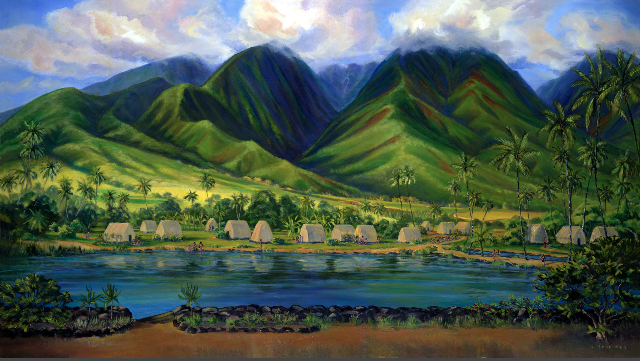
When Lahaina was the capital of the Hawaiian Kingdom in the early 1800s, the royalty lived in a lush waterscape of fishponds and wetland taro fields. To the north and to the south of their town were deserts, but Lahaina with its streams and springs was a wetland. It was so green that a British sea captain in the 1790s is said to have called it “the Venice of the Pacific.”
But in our time Lahaina was dry and brown, like a desert. On the mountainside above Lahaina there were no more trees to cool the upland soil; they’d been taken away in the early 1800s. There was no more water flowing down from the mountain either, because in the late 1800s it had all been diverted to the sugarcane fields.
Because in the mid-1800s, soon after the Kingdom of Hawaiʻi moved its capital out of Lahaina, a young Irish carpenter and his business buddy saw an opportunity. They built a sugar mill, the Pioneer Mill, outside Lahaina and planted some sugarcane fields. But their dry fields needed water. So they got permission from the Hawaiian Kingdom to take some of the water from Lahaina’s main stream, and in 1882 they built a ditch.
But then a decade later, in 1893, the sugar planters and businessmen from all across the islands, with the support of the US Navy, organized to overthrow the Hawaiian government, and they staged a successful coup against the queen. After that the sugar barons went wild for the water. They planted more and more acres of sugar and built more and more diversion ditches until just a few decades later, the 1920s, the Pioneer Mill was taking all the water out of all the streams of the West Maui Mountains.
In old Hawaiʻi, turning water permanently out of its streambed was against the law. It wasn’t just illegal, it was unthinkable. Because to the Hawaiians, ola i ka wai: water, wai, is life.
The Hawaiians too had been diverting water for centuries with irrigation ditches and terraces that stretched away from every stream. But they also had strict rules about sharing. If people upstream were hogging more than their share of water behind a dam, those downstream could legally walk uphill and dismantle that dam. Streams in old Hawaiʻi flowed all the way to the sea, feeding taro fields higher up and fishponds farther down. There were strict penalties for hoarding water or wasting water, and those penalties could include being thrown off your land and having your water taken away—in other words, starvation. Water was for everyone, and for everyone equally.
But the sugar planters played by capitalist rules. So they took the water for themselves, forcing it away from its ancient pathways. Making water do their bidding. Sending it where they wanted it to go, which was where it would profit them personally at the expense of the rest of the community.
It was not where the water wanted to go. Because water has its own will. Water carries on its own dialogue with land. It’s an age-old dialogue—the slope of the land indicating the path for water to flow, the water following that slope and in return carving the land. Earth and water shaping each other over millennia, their dialogue visible to us now in the clefts of a hillside, in the flowing of a creek in a valley, in the gathering of water into wetlands near a coast.
But the sugar barons did not hear any of that dialogue. They did not care about the other members of the community. They had fortunes to build. When they took water from the streams, the terraces of the people downstream dried up, forcing the people off their land. The displaced people had to go to work in the sugar fields and became dependent on the plantation for housing and food. Sugarcane fields eventually stretched for ten miles along the West Maui coast—more than ten thousand acres of sugarcane sucking water from every last one of the streams flowing down from the West Maui Mountains. The colonizing by sugar barons was complete.
Forcing others to do our will especially when it harms them is abuse. Forcing water out of where it wants to go is also abuse when it harms the land or the people who belong there. The sugar planters abused the water and the land, exploiting them for their own riches.
And when land is abused, the people suffer.
I’m all too familiar with this habit of colonizing water because I have a personal connection to it. I was born on land that wants to be a wetland, in the northwest corner of Ohio. It’s a low-lying area that extends out from the west corner of Lake Erie as far as Indiana, and for ten thousand years after the glaciers retreated, it was a wet and swampy deciduous forest rich with animals and birdsong and, yes, mosquitoes too.

But in the mid-1800s, the same era when sugar planters began to divert water on Maui, my great-great-grandparents and others moved onto this swampy land. They cut down the forests for their fields, leaving only tiny stands of woods scattered here and there to the horizon, and they planted their crops. But without all those trees to take up the water, their fields always flooded. So farmers spent the last half of the 1800s running drain tiles up and down the countryside to make the water flow away from their fields.
Here on Maui the white settlers forced water to their fields; in northwest Ohio, the white settlers forced water away from their fields. But it was the same mindset: compel water to do your bidding. Send it where you want it to go. Reshape the land to benefit your own family and your own people, no matter what others need. And in northwest Ohio it meant removing the Ottawa people and other tribes who had lived around the wetland and hunted within its forests since forever.
Sometimes I think the entire history of Western colonialism could be written in the stories of conquering water. Displacing water is often the first step in conquering people and land. And Europeans have been displacing water for a very long time.
Farming came to Europe seven or eight thousand years ago, and it was an intensive kind of farming that depended on clearing trees and plowing fields for single crops. Growing food this way takes a lot of water—but not too much of it. So Europeans have been sending water to and fro for thousands of years—to their crops for irrigation, away from their fields for flood control. In the land of Greece the ancient Myceneans built a water system to drain a shallow lake for planting, so the tradition of reclaiming land goes back at least to them, at least to 1500 BCE.
But think about that term, “reclaimed land.” It’s a conqueror’s term for what is really abused land. Land that has lost the life-giving power of wetlands. Because people with eyes for plows have trouble seeing all the gifts of wetlands: how wetlands grow plants that give food and medicine and housing to people and animals and birds. How wetlands purify water so that land and sea creatures stay healthy. How wetlands prevent shorelines from eroding away. In the eyes of European farmers, wetlands were wasted land.
This week I ran across the website of a British civil engineering society that takes pride in draining swamps. The website talks about the draining of the Fenlands of eastern England, an enormous project that started in the early 1800s—the same era we’ve been talking about here. The website says that draining the fens, quote, “solved the problem” of the water because it—again quoting—“made unusable marshes and bogs into land for crops and animals.”
Note the starting point here: that land is “unusable” if it is not being plowed and planted and built on. This is the starting point of Western thinking about land. It is the mindset of people who have set themselves against the land, who see their own interests as opposed to those of water and earth. And it is a deadly mindset. We can’t separate our welfare from that of water and earth without serious consequences.
I call this the starting point of Western thinking about land because diverting water, quite literally, made possible the first city in recorded Western history. Five thousand years ago in ancient Mesopotamia, the city of Uruk sat beside the Euphrates River. And to feed its people the city built enormous irrigation works, diverting water from the river and sending it to the barley fields outside the city. The fields were so large and the amount of grain needed for the city so great that the city depended on compulsory labor. At planting or harvest, every family in the region had to provide one man for a month of unpaid labor in the city’s fields. It meant that each family was deprived of the labor needed to tend their own fields and gardens, and they gave up a month’s wages.
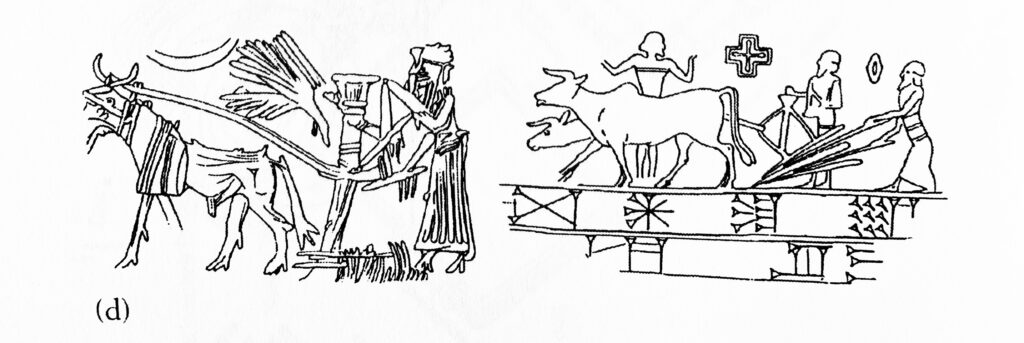
So here, at the very beginning of recorded Western history, is that dual pattern of abusing land and exploiting the people who live there to do it. The irrigation system of Uruk did abuse the land because it was done with no attention to what the land needed or wanted. So irrigation resulted in one huge unintended consequence: it salted the land. The river water carried mineral salts that it had picked up from flowing down over rocks in the mountains, and when the water slowed to a stop in the fields, it released those salts into the soil. Irrigating the soil raises the water table of an area, and doing it continuously without giving the land time to rest and recover brought those salts to the surface and kept them there. Eventually the ground in the lowland areas of Mesopotamia became too salty to grow food. Today those areas of Iraq are dry deserts covered with salty, sandy dunes.
When the Mesopotamians sent the water where they wanted it to go, they stole something from the land—they stole its fertility. Theft is a form of abuse.
And when the land is abused, the people suffer.
Draining the swamps of northwest Ohio was also stealing from the land, and it too is having serious repercussions. Eliminating the wetlands took away the power of the land to purify the water flowing into Lake Erie. The runoff from today’s farms is full of fertilizers and pesticides, and when those extra chemicals flow into the lake they create toxic algae blooms. At Toledo, Ohio, where the waters from what were once the Great Black Swamp enter the lake, those toxic blooms are now an annual event, and they threaten the drinking water of millions.
When water is abused, the people suffer.
And today on Maui we are suffering the deadly consequences of stealing water from the land of Lahaina. The once-green land had turned brown like a desert, and now fire has destroyed it so completely that nothing is left but gray ash. The fire in Lahaina may have burned this month, but it was sparked a century and a half ago in the theft of water from the land.
Western law gives a lot of attention to stealing and theft. In fact, as we saw in episode 34, the Western system of law has its roots in protecting property from being stolen by others. But our system of law cannot see this other kind of theft—stealing from the land itself. Western law has no means of addressing this offense because it has never even recognized it as an offense. Which is why movements for putting the rights of nature into law are so important: they shift the law away from seeing human interests as opposed to the land. Current law allows landowners to destroy land or water or wetland if they think it conflicts with their interests, but rights-of-nature laws move the whole system of law toward caring for land.
When the land is cared for, the people thrive.
Caring for land, mālama ʻāina: this is one of the most deeply held values in Hawaiian culture. Mālama means to nurture and care for and serve the ʻāina, the living Earth. In Hawaiian culture people and land and waters are all related, all one family. Hawaiians believe the land is our ancient and older sister, and as the junior members of the family, we the people have the duty of keeping our elder sister happy.
Hawaiian historian and professor Lilikalā Kameʻeleihiwa writes, “The Hawaiian does not desire to conquer his elder female sibling, the ʻĀina, but to take care of her, to cultivate her properly, and to make her beautiful with neat gardens and careful husbandry.” Caring for the land in this way allowed the Hawaiian people and lands to flourish.
I remember something that my friend Malidoma Somé said many years ago. In his village in West Africa, he said, when a couple decides to marry, they first choose a spot to build their new house. But the next step is not to gather tools or materials. The next step is to ask permission of the land: Is it okay with the land to build a house in this place?
At the time I wondered if that was really necessary. Like, how do the people get anything done if they need to stop and ask permission? Once I’d made a decision I usually liked to barge ahead. But that was then, and today, I hope I’m a little wiser and a lot more humble. I see now that asking permission takes many forms, and it’s another way of talking about mālama ʻāina, caring for and serving the land.
Here in Hawaiʻi, caring for and serving water always meant, first of all, sharing it equally with others. Not allowing upstream users to take more than their share. Not ever taking so much water out of a stream that the stream cannot reach the sea.
Looking out for the good of the stream and the good of other users seems to me to be one way of asking permission. Are we acting for the good of all? Does this venture benefit everyone, not just me and mine? These are questions we need again on Maui, and everywhere.
We also care for water when we work for justice for water. Stream restoration makes it possible for water to flow again where it wants to go. Cleaning rivers restores the health of water. Stopping fossil fuel emissions will benefit all the waters of the Earth. Reforesting the hillsides above streams, if they used to hold forests, is a kindness to those streams. In northwest Ohio, people are thinking about restoring part of the Great Black Swamp so the land is again able to purify the water before it enters Lake Erie. Working for water is mālama ʻāina. It’s a way of seeing water as prior to ourselves and fitting ourselves into our elder sibling’s way of being.
Restoring the streams of Lahaina is on many people’s minds here, especially those of the Kānaka Maoli, the Native Hawaiians, who have been fighting for many years to get their water rights back.
Which highlights what may be the most important way to care for water: restoring justice to the people from whom the water was stolen. Giving the stewardship of water back to the people with the knowledge of caring for it.
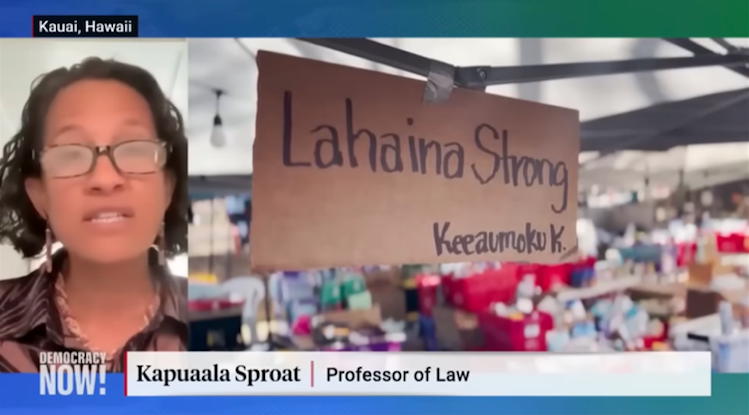
This is why the Land Back movement is so crucial: it’s a movement to give Indigenous lands back to Indigenous people. It’s also a movement to restore the practice of sharing of land and resources instead of getting rich off them. In this moment of crisis on Maui, those who wish to profit are swooping in to grab up land. But in a moment like this, when old structures have been swept away, we also have a huge opportunity to take big steps in a different direction, toward Hawaiian sovereignty and Hawaiian care for water.
Finally, a personal note. I want to thank each of you who reached out to ask if we were okay. Yes, we are fine, though we did get an evacuation order that night because of another fire much closer to us. We packed up, ready to go. But here the air was calm and still and the fire did not travel. I am grateful to each of you who thought of us and sent your messages of care. I felt the love in each note!
And I’d like to end today with a request: that if you are able, and you haven’t already, please consider donating to Maui, especially if you’ve ever enjoyed Maui’s hospitality. I’m adding links for donations to the transcript. We need your help—for the people affected and for building equity and justice on Maui for people and water and land. Because we are all connected. We are all family.
Sending aloha to each of you and mahalo, thanks for your care.
To donate
Maui Fire Relief & Recovery Fundraiser, for community organizing and equity
Maui Food Bank
Maui Strong Fund of the Hawaiʻi Community Foundation
Maui Humane Society
For digging deeper
In addition to climate change, nonnative grasses also made this fire burn hotter and faster. See Sophie Kevany, “Non-Native Grass Species Blamed for Ferocity of Hawaii Wildfires,” Guardian, August 16, 2023. Research at the University of Hawaiʻi at Mānoa shows that fires in nonnative grasses burn 3 to 5 times faster than fires in forests, and the flames are 2 to 3 times higher. See Lisa Ellsworth et al., “Invasive Grasses Change Landscape Structure and Fire Behaviour in Hawaii,” Applied Vegetation Science 17 (2014): 680–89, available for download at College of Tropical Agriculture and Human Resources at the University of Hawaiʻi at Mānoa.
For the ship captain’s quote about the “Venice of the Pacific,” see Peter T. Young, “Lāhainā Canal,” Images of Old Hawaii, November 27, 2019.
A summary of Lahaina’s water history can be found in Conrad (Mac) Goodwin, “Lands of the Pioneer Mill, Lahaina, Hawaiʻi,” paper presented at the Association of American Geographers (Honolulu, Hawaii, March 1999), available at academia.edu. If you need access to the paper, please contact me.
For an overview of how water was understood and treated from traditional Hawaiian kingdom times through the plantation era, and for update on restored streams, see Lurline Wailana McGregor, “Ola I Ka Wai: Water Is Life,” Ka Pili Kai 1, no. 2 (2019): 9–16, at the Hawaiʻi Sea Grant Program, University of Hawaiʻi.
On the traditional penalties for the abuse of water, see Claire Hiwahiwa Steele, “He Aliʻi Ka ʻĀina; He Kauwā ke Kanaka (The Land Is Chief; Man Is Its Servant): Traditional Hawaiian Resource Stewardship and the Transformation of the Konohiki,” MA thesis (Honolulu: University of Hawaiʻi at Mānoa, 2015), 15, at Scholar Space of the University of Hawaiʻi at Mānoa.
For more on the 1893 coup, see Jesse Greenspan, “When Hawaii’s Monarchy Was Overthrown, with Rogue US Support,” May 16, 2023, History website.
Historian Lilikalā Kameʻeleihiwa is the author of Native Land and Foreign Desires: Pehea Lā E Pono Ai? How Shall We Live in Harmony? (Honolulu: Bishop Museum, 1992); quote is from chap. 2. For her talk on Hawaiian deities, temples, and star knowledge, see “Measuring the Elements: A Lecture by Lilikalā Kameʻeleihiwa,” APA Institute at NYU, 2016.
For a great introduction to the Great Black Swamp and the forced removal of the Ottawa, see Kaycee Hallett, “History of the Great Black Swamp,” The Black Swamp Journal of the Journalism & PR Department of Bowling Green State University, April 14, 2011.
On ancient Mycenean water works, see D. Koutsoyiannis and A. N. Angelakis, “Agricultural Hydraulic Works in Ancient Greece.” Found under a different title in Encyclopedia of Water Science, ed. B. A. Stewart and Terry A. Howell (New York: Marcel Dekker, 2003), 415–17.
The Institute of Civil Engineers talks about the “unusable” Fenlands of England at “Draining the Fens.”
For Mesopotamian farming, see Mario Liverani, Uruk: The First City, ed. and trans. Zainab Bahrani and Marc Van De Mieroop (Sheffield, UK: Equinox, 2006), chap. 3. For the salination and desertification of this region of land, see archaeologist Susan Pollock, Ancient Mesopotamia: The Eden That Never Was (Cambridge: Cambridge University Press, 1999), 37–39.
This superb article from the Guardian answers the question of who controls West Maui’s water today: Naomi Klein and Kapuaʻala Sproat, “Why Was There No Water to Fight the Fire in Maui?” Guardian, August 17, 2023. More on streamflow from Native Hawaiian perspective at “Who Owns the Water in Hawaiʻi?” by Michele Bigley, Sierra Magazine, April 27, 2023. The New York Times summarizes the governor’s moves to loosen restrictions on diverting water in “Lahaina Fire Prompts a Shift in Maui’s Long-Running Water Fights,” by Michael Corkery, Mike Baker, and Shawn Hubler, New York Times, Aug. 20, 2023.
For a recent summary of rights-of-nature laws, see Yaffa Epstein et al., “Science and the Legal Rights of Nature,” Science 380, no. 6646 (May 19, 2023). A parallel movement to stop ecocide would make ecological damage a crime against peace in parallel with, for example, genocide; see Stop Ecocide International, “Making Ecocide a Crime.”
On restoring part of the Great Black Swamp, see William J. Mitsch, “Solving Lake Erie’s Harmful Algal Blooms by Restoring the Great Black Swamp in Ohio,” Ecological Engineering 108 pt. B (November 2017): 406–13.
An example of Land Back is restoring the national parks to Indigenous control. See David Treuer, “Return the National Parks to the Tribes,” Atlantic, May 2021.















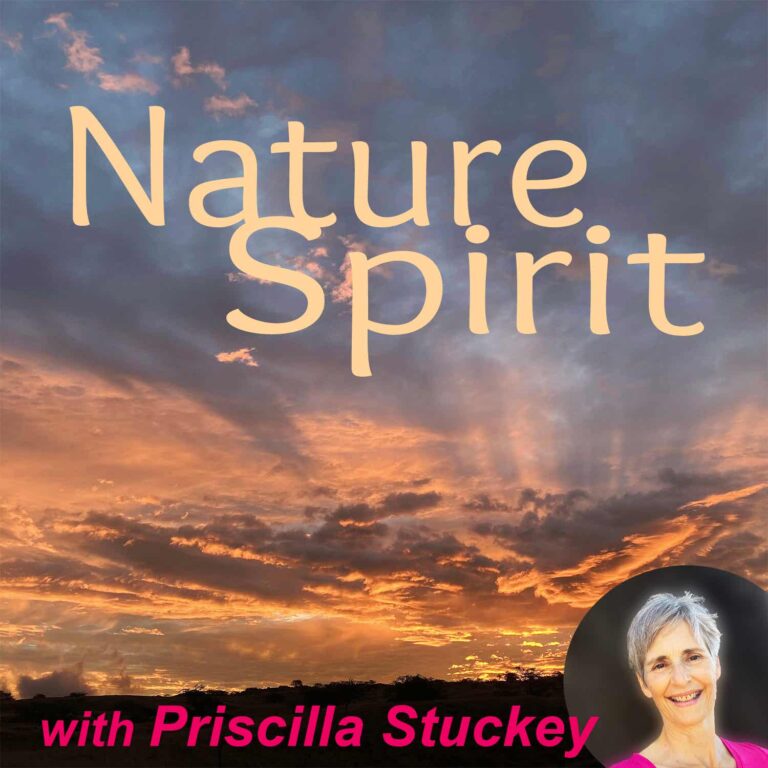
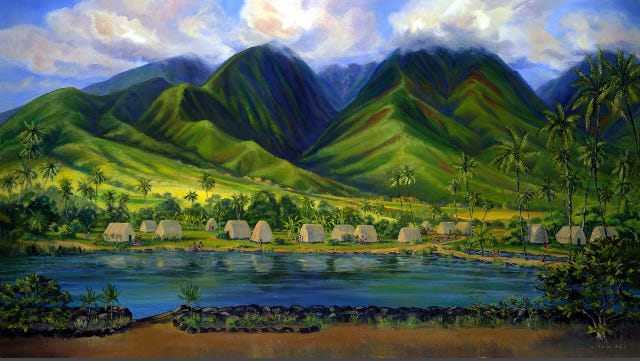
A fascinating read, an important message, and a harrowing story, not just in the context of Maui and Lahaina, but as you point out, a recurring narrative that can be identified on every continent, and probably in every country. I appreciate the in-depth research you conduct for these podcasts Priscilla, and the extensive reference list for further reading. So glad to hear you are personally safe, but I grieve for those who have lost family and friends; property and possessions. Have linked to this episode on my blog:
https://denzilnature.com/2023/08/24/what-led-to-the-fires-in-lahaina/
Many thanks as always, Denzil. As I try to imagine better directions to go, understanding how we got to this point is crucial. I hope drawing some of this history together helps people imagine better ways to be—and gives us the courage to BE those better ways.
Thank you for digging deeper into what’s happening in Maui. I shouldn’t be surprised that the fire’s origins started a long time ago with those who colonized Hawaii for their own purposes. It’s shameful and sad, and I so appreciate that you gave a bigger picture of what’s happening–not just in Hawaii but across the world, including your own native Ohio. I really appreciate this insightful piece.
Thanks for the good words, Kathy. I really hope that knowing what happened in the past can help us chart more Earth-friendly courses now and in the future. Our survival depends on reconciling with water and land instead of fighting (conquering) them.
This is such a beautiful and moving article. Thank you for sharing the historical perspective and for pointing the way to new possibilities.
Aloha,
Beth
Mahalo, Beth, for the good words, and thanks for dropping by! It IS possible to find better ways forward. Here’s hoping everybody uses our voices in whatever ways we can.